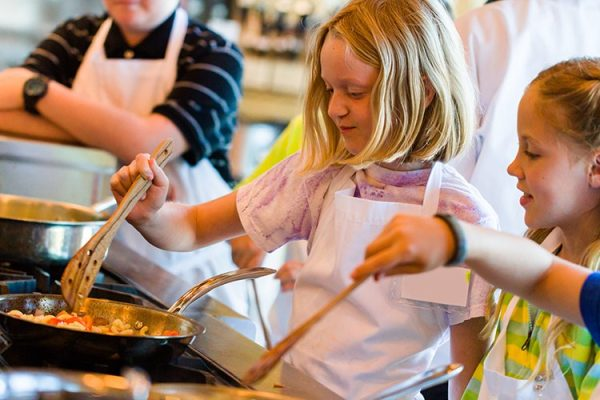
Sometimes, cooking for children can seem like a task that doesn’t receive any gratitude. When kids turn down new foods and are completely unaware of the substantial effort put into preparing a meal, it’s easy to get frustrated. At this point, parents might want to think about cooking together with their kids. Having kids help in the kitchen can break down some of their prejudices against certain foods. Cindy Roberts, the head chef at a kids’ cooking school, shares how an expert helps kids learn to cook.
Each of Roberts’ weekly summer camps showcases a different type of cooking: chocolate, world cuisine, and handmade pizzas are just some of the tempting (诱人的) offerings this year. She likes to emphasize the joy and creativity in cooking. Cindy Roberts started cooking at the age of 3 and believes cooking can inspire as well as educate. “I focus on the ‘fun’ aspect of cooking,” Roberts points out, “but I also teach them the health, cost and taste benefits of home cooking.”
Roberts is aware of a method that parents can use to expand the range of foods that picky eaters are willing to try: involving them in the decision-making process by giving them a voice. “Have them taste test something... and encourage them to offer suggestions for enhancements,” Roberts recommends. In her cooking classes, asking the kids to experiment directly with ingredients “gets even the most finicky (过分挑剔的) eaters trying out what we made and giving it a second chance.” In other words, the more they know about how a dish is prepared, the more they can keep an open mind, even about foods that they initially had no interest in or were reluctant to try.
When asked what the kids in her classes find most surprising about cooking, Roberts says that young chefs are completely amazed at how easy it is to make some of the products they buy packaged at the grocery store”. The homemade versions wind up being fresher and better-tasting. Empowerment (权利赋予) and self-confidence: these two ingredients are welcome on any family menu.
原创编写 版权所有 侵权必究! 每日更新 个性化阅读 英语飙升!
1.1. What might make parents depressed when cooking for kids?
A Kids’ lack of interest in cooking.
B Kids’ rejection of new dishes.
C Kids’ preference for junk food.
D Kids’ inability to cook.
解析:选B。细节理解题。根据第一段“When kids turn down new foods and are completely unaware of the substantial effort put into preparing a meal, it’s easy to get frustrated.”可知,孩子拒绝新食物且无视家长付出的努力会让家长沮丧。选项B“孩子拒绝新食物”是该表述的简化,故选 B。
2.2. What can be inferred about Cindy Roberts’ teaching philosophy?
A She prioritizes cooking speed over quality.
B She believes strict recipes are most important.
C She combines enjoyment with practical benefits.
D She focuses mainly on nutritional education.
解析:选C。细节理解题。根据第二段中Roberts明确指出:“I focus on the ‘fun’ aspect of cooking... but I also teach them the health, cost and taste benefits of home cooking.”可知,她既强调烹饪的趣味性,又注重传授家庭烹饪的健康、经济和口感优势,体现了乐趣与实用价值的结合。故选 C。
3.3. What’s the outcome of involving kids in the decision-making process?
A It makes children refuse to eat new foods.
B It reduces parents’ control over meals.
C It focuses solely on improving cooking skills.
D It increases children’s willingness to try unfamiliar foods.
解析:选D。推理判断题。根据第三段内容,让孩子参与决策(如试吃并提出改进建议)能使“最挑剔的食客”重新尝试食物。由此可推断,这种方法能提升孩子对新食物的接受度。故选D。
4.4. According to Roberts, what surprises kids most in cooking classes?
A Cooking requires expensive equipment.
B Homemade dishes are less tasty.
C Cooking at home is easier than expected.
D Parents are unwilling to try their creations.
解析:选C。细节理解题。根据最后一段中的“young chefs are completely amazed at how easy it is to make some of the products they buy packaged at the grocery store.”可知,孩子们惊讶于“自制食品的过程比预期简单”。故选C。